Read Reviews
The Best Petrol Strimmers
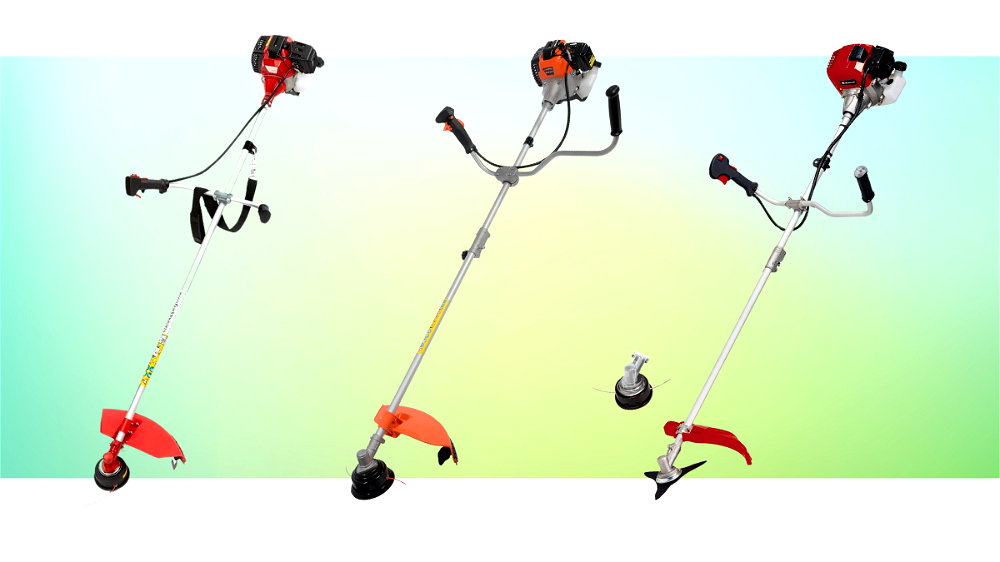
-
Best heavy duty petrol strimmer - ParkerBrand Petrol Strimmer & Brush Cutter
-
Best lightweight option - McCulloch Trimmac Petrol Trimmer
-
Best budget petrol strimmer - Trueshopping Heavy Duty Petrol Grass Trimmer
-
Best for manoeuvrability - Einhell Two Stroke Petrol Engine Garden Trimmer
-
Best value petrol strimmer - Ryobi 2-in-1 Petrol Strimmer & Brush Cutter
Reviews
1. ParkerBrand Petrol Strimmer & Brush Cutter
Best heavy duty petrol strimmer
- Quick to assemble in around 15 minutes
- Easy to start whether the engine is hot or cold
- Very powerful at 2.2 kW and 7500 RPM - best suited to heavy duty tasks
- The included harness balances the weight well
- At 10.7 kg, this strimmer is heavier than others on the market which makes it more difficult to hold for extended periods
- When used at high revs, this strimmer gets through fuel very quickly
- Not very comfortable for left handed users because of the layout of the handles and buttons
- Due to the high power and heavy weight, this strimmer is best suited to those with experience with high-power tools
- Engine
- 52 cc
- Head Size
- Not listed
- Blade Length
- 25.5 cm
- RPM
- 7,500 RPM
- Bump Feed Line
- 2.4 mm
- Weight
- 10.7 kg
- Design
- 4.5
- Performance
- 4.4
- Ease of Use
- 4.3
- Assembly Ease
- 4.6
- Value for Money
- 4.6
The ParkerBrand 52cc Petrol Garden Brush Cutter steps things up a notch in terms of power: with a 52 cc engine, it has almost 10 cc more than the next-most-powerful on our list of petrol strimmer reviews.
This is the sort of machine that you might need if you’re looking to tackle some serious undergrowth in the garden, we’re talking brambles, nettles, ivy, etc…!
There’s a brush cutting blade included as well as an auto-release line head, but you might not even find yourself using the blade much as it’s powerful with the line alone.
At 10.7 kg, this is one of the heavier petrol strimmers featured here, but there are a couple of things that help make it more comfortable. Primarily, there is a decent harness included that is more than just a single shoulder strap; it’s adjustable, with padded coverings and should distribute the weight well.
The handle position is also adjustable, so users of different heights can find the position that is most suitable, and the engine also starts relatively easily which will reduce fatigue from pulling the engine cord.
On an aesthetic note, the finishes, such as the buttons, components and strimmer head, may be a bit crude in comparison to more premium models, but the general consensus seems to be that this doesn’t affect the running of the strimmer itself and it still offers good value.
Along with the harness, a tool kit and fuel-mixing bottle come included. Whilst you may get more from using your own tools for maintenance, the bottle is useful for easily combining the petrol and oil needed before starting.
Overall, this is a pretty heavy-duty strimmer which should get through a lot of difficult undergrowth as long as you can cope with the weight of it.
Did you find this review helpful?
2. McCulloch Trimmac Petrol Trimmer
Best lightweight option
- At 3.9 kg, this is a very lightweight trimmer which makes it easy to move in and out of storage
- Once used, it starts first time almost every time
- Comfortable for both left and right handed users
- Very efficient on fuel consumption which makes it good value
- A good option for those with smaller gardens
- You can't attach a shoulder strap because there's no-where to hook one on to
- Like most 2-stroke models, this strimmer is relatively noisy
- Lacks the power of larger and heavier trimmers, at just 0.6 kW - may struggle with very heavy duty tasks
- No mixing bottle for oil and fuel included, unlike other petrol strimmers
- Engine
- 25 cc
- Head Size
- 40 cm
- Blade Length
- n/a
- RPM
- 10,000 RPM
- Bump Feed Line
- 2 mm
- Weight
- 3.9 kg
- Design
- 4.5
- Performance
- 4.3
- Ease of Use
- 4.5
- Assembly Ease
- 4.3
- Value for Money
- 4.4
If you need the force of a petrol machine, but aren’t sure if you can handle the weight of one, the McCulloch Trimmac Trimmer finds a good balance between power and manageability.
Despite having a 25 cc engine, at only 3.9kg it’s the best lightweight petrol strimmer on our list. For those who are worried about managing heavier weights, but still want something with plenty of power, it’s a great option.
Particularly if you have areas of your garden that get easily overgrown and can’t be reached by the mower, this is an easy tool to take out and neaten up those smaller spaces – the 40 cm cutting width can get into tighter spots without being so small that the job will take ages. Given its slimline design, it’s also easier to work in these narrow areas than a strimmer with wider handlebars would be.
However, it does have its limitations, and you shouldn’t expect to be able to charge this strimmer through brambles or very thick vegetation. It’s a lightweight strimmer that works well for lightweight tasks.
There is a bump-feed head that feeds out line, but no brush-cutter blade head; although, again, this makes sense given the type of work it is suited to.
In terms of storage, this might be easier to store than some other petrol strimmers. It can be split into two parts making it a lot more practical to pack away, or even transport, when necessary.
It also doesn’t seem to vibrate as much as other petrol models, but this is likely due to its lower power output. However, if you only want something for quickly completing light gardening tasks, then its comfort, light weight and manoeuvrability certainly work in its favour.
Did you find this review helpful?
3. Trueshopping Heavy Duty Petrol Grass Trimmer
Best budget petrol strimmer
- The adjustable bike-style handlebars spread the 8.25 kg load evenly and comfortably
- Can cut through taller grass
- Relatively easy to assemble despite the small instructional pictures
- Starts after just a few pulls even when cold
- Can be very well balanced as long as time is taken to adjust strap and get used to handlebars
- Engaging the throttle is a little tricky as you’ll need to press 3 buttons at the same time
- Vibrates a lot which can become uncomfortable over time
- Very loud so may disrupt family members and neighbours, and ear protection is needed
- Engine
- 43 cc
- Head Size
- 46 cm
- Blade Length
- 25 cm
- RPM
- 9,500 RPM
- Bump Feed Line
- 2.5 mm
- Weight
- 7.4 kg
- Design
- 4.4
- Performance
- 4.5
- Ease of Use
- 4.3
- Assembly Ease
- 4.5
- Value for Money
- 4.5
This Trueshopping Garden Trimmer is the best petrol strimmer to buy on a budget because, even though it’s inexpensive, it’s still extremely well designed. It comes with secure bike-handlebar handles which, when combined with the shoulder strap, create a very stable machine.
This is just as well, as it’s a relatively powerful 43 cc 2-stroke petrol strimmer with both a bump-line feed head and a brush-cutter blade. For the most part, the line head is able to work through a lot of tough undergrowth, like long grass and brambles, so you may find there’s not even much need to change to the brush cutting blade.
Getting the hang of balancing the machine can be initially difficult, especially if you’re used to more conventional strimmers, but the design generally seems to distribute the 8.25 kg weight well across the body. It may be a little heavy for some users, depending on upper-body strength, but it’s still a relatively average weight for a petrol strimmer with a motor of this size.
It’s also possible to adjust the height and angle of the handlebars to make them better suited to the height and preferences of different users.
When it comes to starting the machine, engaging the throttle can be a little challenging as the throttle lock, throttle, and one other button all need to be pressed simultaneously so that they stay depressed – initially this could be challenging, but should get easier as you get used to it.
Did you find this review helpful?
4. Einhell Two Stroke Petrol Engine Garden Trimmer[ SAVE 33% ]
Best for manoeuvrability
- The shaft can divide into two so it can be reduced in length for easier storage
- A good medium-duty strimmer - producing 1.5 kW of power that can handle most brush and grass
- Starts easily when the engine is either hot and cold
- The included instructions are lacking and assembly may take over an hour
- Fairly heavy at 8.9 kg and the included harness is difficult to adjust
- There can be a lot of vibration when using the blade, and still some, although less, with the line cutter
- Engine
- 52 cc
- Head Size
- 42 cm
- Blade Length
- 25.5 cm
- RPM
- 7,200 RPM
- Bump Feed Line
- 2.4 mm
- Weight
- 8.9 kg
- Design
- 4.3
- Performance
- 4.5
- Ease of Use
- 4.4
- Assembly Ease
- 4
- Value for Money
- 4.3
No matter the size of your garden, you might find that there are small areas where it’s impossible to take a mower. Most strimmers have a cutting width of around 40 cm, so they can still struggle to get into tighter spaces, but the Einhell Two Stroke Brush Cutter has a blade attachment of 25.5 cm. It’s one of the best machines for manoeuvring into narrow spots.
Whether you choose to attach the blade or line cutter, the cutting action is powered by a 52 cc motor – even if you’re working with a garden full of brambles, this Einhell strimmer can cut through, shred them up, and clear the space.
It weighs 8.9 kg and has handlebar-style handles to provide a good grip on the strimmer – especially useful when working through tougher terrain; however, the harness could be of better quality to help more securely distribute the weight.
The two-stroke engine starts relatively easily and requires a combination of petrol and oil, and you should consider using ear protection as well – it’s quite a noisy machine.
Working in its favour is its power, but you might find that you need to rest frequently if using this machine for long periods, especially with the blade attachment, as the vibrations can be uncomfortable.
As with some other models, it can be split into two pieces which will make it a lot easier to store or transport than fixed-shaft strimmers. Therefore, this could also be a good option if you think friends or family will also want to borrow your strimmer for their own gardens.
Did you find this review helpful?
5. Ryobi 2-in-1 Petrol Strimmer & Brush Cutter
Best value petrol strimmer
- Well balanced which makes this 8 kg model feel lighter than it is
- Reasonably quiet compared to other petrol motors
- Can cut through brambles
- Generally easy to get started when cold
- The included assembly instructions aren’t not very easy or intuitive to understand which makes assembly take longer than necessary
- The vibrations can become uncomfortable over time
- Taller users may find that they have to stoop as the pole length isn't very long
- May need a couple of minutes to cool down if trying to start it when the motor is warm
- Engine
- 25.4 cc
- Head Size
- 43 cm
- Blade Length
- 26 cm
- RPM
- Not listed
- Bump Feed Line
- 2.4 mm
- Weight
- 8 kg
- Design
- 4.7
- Performance
- 4.7
- Ease of Use
- 4.4
- Assembly Ease
- 4.2
- Value for Money
- 4.5
For neatening up lawn edges, as well as cutting through tougher shrubbery like brambles, the Ryobi 2 in 1 Petrol Grass Brush Cutter is a solid choice: powerful yet lightweight.
You have a choice of using either a brush-cutter blade or a head with a bump-feed line, so whether its just tidying up the grass, or beating back tougher plants, this model can be adjusted to either task.
The line head has a 43 cm cutting path so it doesn’t take long to cover larger areas either; if you have parts of the garden where the mower can’t go, this strimmer should be able to get in and help keep things looking tidy – especially useful around fountains, benches and playgrounds.
There’s a 24.55 cc engine which is surprisingly powerful for something packed into an 8 kg unit, and a shoulder strap is included to maintain better control and precision whilst strimming.
Generally, it seems this model is quieter than competing petrol strimmers, which might make it a bit more ‘neighbour friendly’, especially if you’re fond of working the early mornings or evenings.
Starting up the motor doesn’t tend to be too difficult either, although it may sometimes be harder to start warm, and need a couple of minutes to cool down.
Did you find this review helpful?
Compare Product Features
Use the dropdown to sort the table by the feature you want to see.
ParkerBrand Petrol Strimmer & Brush Cutter
- 4.5
- 52 cc
- Not listed
- 25.5 cm
- 7,500 RPM
- 2.4 mm
- 10.7 kg
McCulloch Trimmac Petrol Trimmer
- 4.4
- 25 cc
- 40 cm
- n/a
- 10,000 RPM
- 2 mm
- 3.9 kg
Trueshopping Heavy Duty Petrol Grass Trimmer
- 4.4
- 43 cc
- 46 cm
- 25 cm
- 9,500 RPM
- 2.5 mm
- 7.4 kg
Einhell Two Stroke Petrol Engine Garden Trimmer
- 4.3
- 52 cc
- 42 cm
- 25.5 cm
- 7,200 RPM
- 2.4 mm
- 8.9 kg
Ryobi 2-in-1 Petrol Strimmer & Brush Cutter
- 4.5
- 25.4 cc
- 43 cm
- 26 cm
- Not listed
- 2.4 mm
- 8 kg
How to Choose The Best Petrol Strimmer
Whether you’re struggling with overgrown grass, shrubbery, weeds or brambles, investing in a petrol grass trimmer is one of the best ways to keep your garden under control.
As tools go, strimmers are up there with the most useful and versatile, plus, both the cost of purchasing and maintaining a petrol strimmer is pretty low.
Considering that petrol strimmers can be very powerful machines, it’s worth doing a bit of research before getting one, to make sure it’s the best petrol strimmer for you, your garden, and your lifestyle.
Here is some useful information to bear in mind before buying a petrol grass trimmer:
Petrol Garden Strimmers Vs. Electric Strimmers
Petrol strimmers aren’t generally used for small jobs – they’re tough machines that are well suited to clearing large areas and tough undergrowth.
There are three main types of strimmer: petrol, mains-powered and battery-powered. Each has its pros and cons, and there are certain jobs which will likely better suit one type than the other. Here we’ll take a look at the advantages and disadvantages of each type:
Battery-Powered Strimmers
These strimmers are generally best suited to light strimming jobs, for example: cutting the grass and clearing small weeds. You should not expect to use a battery-powered cordless grass trimmer to cut plants with thick stems, like brambles. A battery-powered machine will often stutter, and maybe even stall, if you attempt to take it through tough foliage.
The main pros of battery-powered strimmers are:
- You are not restricted by cables. This makes them more relaxing to use than a mains-powered machine with cables that you could accidentally cut through. Battery strimmers are also quick to start using straight away, without organising an extension cable, and well-suited to use in large gardens.
- Battery strimmers are both cordless and lightweight, unlike petrol strimmers which are cordless but heavy.
- They are the most practical strimmers for quickly neatening up areas where the mower can’t reach. Battery-powered strimmers are no hassle to get out of the shed, meaning you won’t be put off using one as often as necessary, and they require no preparation (apart from charging the battery when it runs down).
The main cons of battery-powered strimmers are:
- You have a finite period of time that you can run the grass trimmer for before the battery runs out. Tougher tasks may make the battery drain faster, and recharging can take the best part of an hour which can be interruptive. As a result, they’re not the most appropriate for longer jobs.
- They can be relatively limited in terms of what they can strim through. As previously mentioned, battery-powered strimmers aren’t the best choice for bigger garden-clearance tasks.
Mains-Powered Strimmers
These strimmers will generally clear weeds and smaller patches of thicker undergrowth. They are less likely to stutter than battery powered machines thanks to their stronger, constant energy flow, but still won’t make it through areas of dense brush.
The main pros of mains-powered strimmers are:
- They’re able to help with clearing some thicker patches of weeds etc. in the garden, whilst still remaining very manageable. Unlike petrol strimmers which can feel unwieldy, mains-powered machines vibrate less and are easier to control.
- There’s no limit on how long mains-powered strimmers can be used for – it doesn’t have a battery to run down and won’t need refuelling. Of course, the motor may need a bit of time to cool down during extended use.
- They bring a decent amount of power, without emitting the fumes of petrol motors.
The main cons of mains-powered strimmers are:
- The power cord. Mains-power strimmers keep you tethered whilst working in the garden. You will likely have to use an extension cable, and need to be aware of where the cable is at all times so as not to cut through it accidentally.
- If you’re hoping to clear dense brush like brambles, mains-powered strimmers will likely get stuck.
Petrol-Powered Strimmers
As mentioned, petrol strimmers are best suited to big garden-clearance jobs. They can generally make their way through brambles, nettles and thicket, often cutting branches of up to 15 mm in diameter. They’re powerful and aren’t always that easy to manage, but they don’t give up easily.
The main pros of petrol-powered strimmers are:
- They’re very powerful and are a good option for clearing larger patches of land.
- You have the freedom of cordless roaming with a petrol-powered strimmer – you can move wherever you wish without being held back by a cable, and there’s no danger of cutting through any power lines.
The main cons of petrol-powered strimmers are:
- They can be a little too powerful. Unless you really need the strength of a petrol model, they may be more difficult to manage than it’s worth. Vibrations can also make them uncomfortable over extended periods.
- Petrol-powered strimmers are generally quite heavy – often over 10 kg – which can be quite difficult to support whilst doing longer jobs, even if a harness is included.
- You’ll need to spend some time prepping the machine before you use it each time. It will need fuel and oil, and a general safety check before using it. Petrol-powered strimmers are not a machine that you simply get out of the shed and use straight away.
As you can see, finding the best strimmer really depends on what you’re going to use it for. Some gardeners may choose to have a battery-powered grass trimmer for quicker jobs, as well as a petrol-powered strimmer for clearing larger areas.
Engine Power
When it comes to petrol-powered strimmers, there is still quite a lot of variation amongst them in terms of engine power output.
Some of the best petrol strimmers for really tough jobs will have a 52 cc engine. Other machines have closer to a 20 cc engine – but which should you be looking for?
Generally, even a 25 cc engine will make be able to cut through thicker growth like brambles; however, they may get stuck slightly more easily than a petrol grass trimmer with a 52 cc engine. Therefore, if you’re working through a very large area of thick vegetation, you might want to go for something closer to 52 cc.
The majority of 20 cc + petrol engines will be capable of clearing dense vegetation etc. But you may have to put it more work driving the machine forwards through the brush if it has less power.
Remember that larger engines often result in a heavier unit. So, to control a powerful strimmer with a 52 cc engine you need to be quite confident in your physical ability.
Starting a Petrol Strimmer
Some people understandably get put off petrol machines because they require more to be done prior to starting than electric tools.
Before talking about the best way to prepare a petrol strimmer so that it’s easier to start, it’s worth mentioning that some petrol machines come with an ‘electric start’ function. This means they can be started with the push of a button, much like an electric machine.
On some strimmers this may be a feature that can be purchased for an additional cost, if it’s not already included. Although it should be said – it’s more common to find on petrol mowers than on strimmers in general.
For the most part, taking care to follow the correct starting procedure can make it a lot easier to start a petrol machine. Here are the steps to follow for starting a petrol strimmer (although do refer to your strimmer’s instruction manual as they can all vary slightly):
- Prepare the fuel and oil. If your petrol grass trimmer has a two-stroke engine, you will need to mix the unleaded petrol and oil together before putting it into the fuel tank. With a four-stroke engine the oil and petrol are not mixed and go into separate tanks. The manufacturer’s instructions will show what type of oil should be used, and what ratio it should be mixed at.
- After filling the strimmer with petrol and oil, press the primer bulb 7 times. Pressing the primer bulb lets some fuel flow from the fuel tank to the carburettor and will help the engine start without too many pulls on the cord.
- Flick the switch of the strimmer so that it is ‘on’. Move the choke lever to the ‘start’ position.
- Lightly press the throttle.
- Now all that’s left to do is pull the cord. Place the grass trimmer on the ground, making sure that its strimmer head is not in contact with the ground. Secure the strimmer in place with both of your feet whilst you pull the start cord. Generally, it should start in 1 – 3 attempts.
READ NEXT: How to Service a Petrol Strimmer
Cutting Line or Brush-Cutter Blades
Most strimmers will come with a cutting-line head and a brush-cutter head; however, some may only have a cutting-line head so it’s worth checking before you buy, depending on what you need.
A cutting-line head uses fast-spinning nylon string to cut through grass. These heads usually have a wider cutting width than blade heads so can cover more ground faster. They should be used to cut grass, and maybe some weeds, but generally shouldn’t be expected to get through thicker vegetation – this can cause the nylon line to break. A lot of gardeners prefer to use cutting-line heads around the base of trees and near roots and rocks – using a blade-head in these areas can cause damage and be dangerous.
Bladed brush-cutter heads are what you’ll need to get through thick undergrowth. The harder blades can chop through thicker stems and are therefore best to have around for tougher jobs.
READ NEXT: The Best Strimmer Heads
Cutting Width
The cutting width of petrol trimmers can range from 25 cm up to around 50 cm.
If the strimmer comes with two head attachments, one of them will likely be narrower than the other, making it more versatile.
Whilst you might want a wider width if you’re trying to cover a large area, one of the other most useful functions of a grass trimmer is being able to neaten up the tighter spots where the mower can’t go.
In these instances, having a narrower cutting width can be useful. This is another reason why it’s useful to have a choice of cutting heads.
READ NEXT: The Best Strimmer Lines For Brambles
Weight, Handles and Manageability
Petrol strimmers can range in weight, although they are usually around 8 – 15 kg.
If you need a lighter machine, there are options available such as the 3.9 kg McCulloch Trimmac Trimmer. Of course, the weight always increases a little after fuel has gone in as well. The downside of a lighter strimmer is that they can vibrate a lot, and they won’t be able to do the same tasks as more powerful and heavy models. That said, they are a good compromise if you want the power of petrol but are worried about manageability.
Manageability is especially important when considering a heavy petrol strimmer. These are powerful machines and, even with a harness, they can feel unwieldy. You need to be relatively confident in your physical ability, especially to use a strimmer over 10 kg.
The type of handle can make a difference in terms of how easy the strimmer is to control. There are generally two types of handles: a bicycle-handlebar style handle, and a U-shaped shaft handle.
Bicycle-handlebar handles allow you to balance the weight of the strimmer between two hands. Whilst this can take a bit of getting used to, it offers a lot of control and stability.
A U-shaped shaft handle offers a place for one hand to hold the strimmer. The other hand is positioned higher up on the shaft of the strimmer. This means that hands are positioned one behind the other in a linear fashion. This may seem more intuitive to some, but is a posture that can take its toll if the strimmer is heavy and used for an extended period.
READ NEXT: The Best Brush Cutters For Brambles
Petrol Strimmer FAQs
If you’ve followed the steps to start your petrol mower and it still won’t start, check the following things:
The fuel to oil ratio needs to be correct otherwise the engine will be difficult to start.
If the engine is flooded, it won’t start. This often happens when the starter cord has been pulled a lot of times, but not quickly enough to start the engine. Flooding can also happen if the primer bulb has been pushed too many times.
To fix this issue you will need to use a spanner to remove the spark plug and let the engine dry out. Replace the old spark plug with a new one, and try to start the strimmer again.
The carburettor may not be getting enough air. In this case, you may need to loosen the screws on the carburettor slightly. If you’re not confident doing this, you can take your petrol strimmer to a garage and have them look at it for you.
Different techniques can be used depending on what you’re trying to do.
To edge a border: if you have two relatively level surfaces, for example a patio that joins onto a lawn, you can use a strimmer to create a sharp edge between the two. Use a nylon line cutting head and keep it parallel to the ground. Find a comfortable working position and maintain the same height as you walk.
To tackle longer grass and thick weeds: this is best done with a petrol strimmer. You should approach the grass/weeds gradually, maintaining a strong stance and tackling the vegetation in a horseshoe shape, taking the strimmer in and out of the area so as not to overload it.
To tackle tougher vegetation like brambles: you will likely need to use a petrol strimmer with a brush-cutter head. Approach the brambles gradually, and be sure to wear protective equipment, whilst maintaining a secure grip on the handles.
If you want to clear a large area of unkempt grass and weeds, a petrol strimmer will likely be the best tool to use. They’re especially useful when clearing larger areas of garden or allotments.
In general, a petrol strimmer is too powerful for small jobs like edging the lawn, so if you’re looking to simply trim down areas smaller areas where the mower can’t reach, you’ll likely want an electric strimmer.
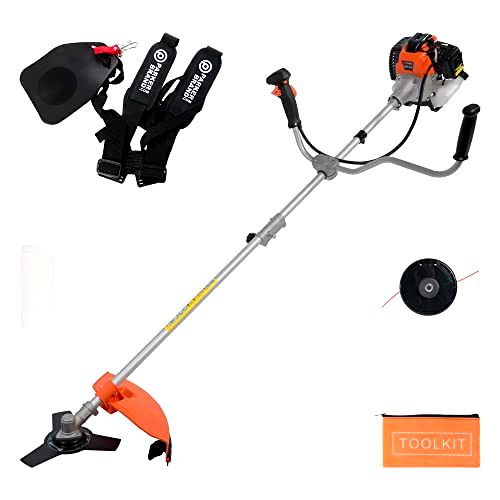
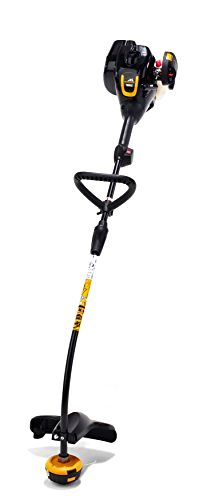
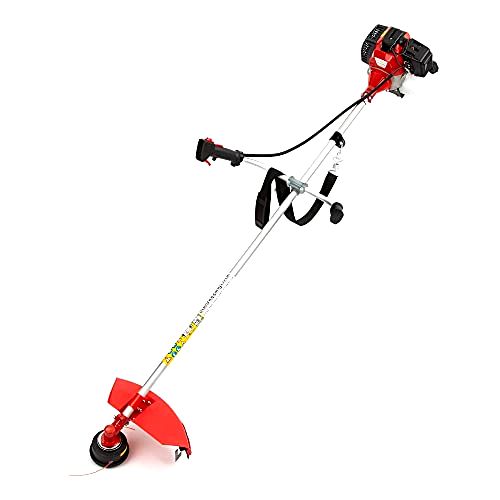
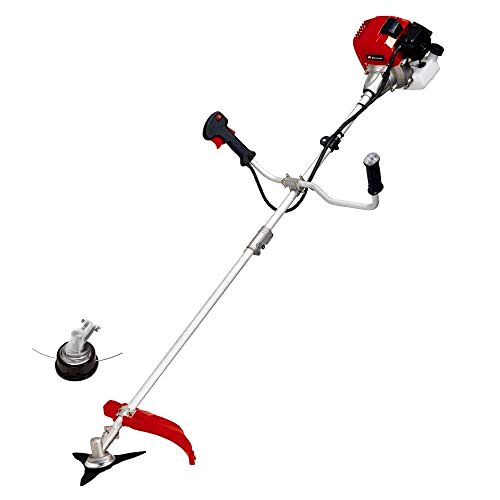
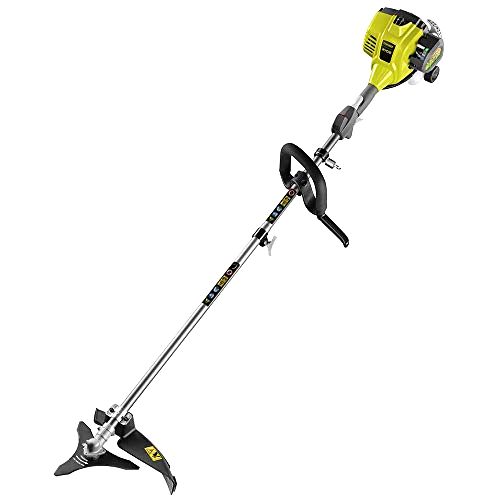

Share